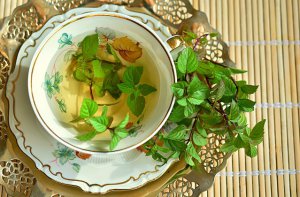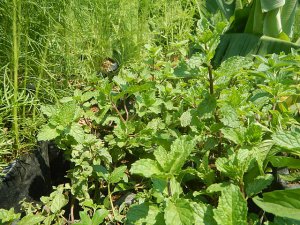The holiday season is full of all sorts of iconic foods and flavors, from Christmas oranges and braided breads, to latkes and gelt at Hanukkah, to holiday feasts featuring favorite dishes on tables around the world. Perhaps the best-known taste of the winter holidays, at least in the West, is peppermint. It infuses sugary candy canes and peppermint brownies, lends itself well to cookies and chocolate bark, and is even showcased in caffeine-laced drinks from Starbucks. But what’s the origin of this refreshing flavor?
What is Peppermint?
Peppermint’s hardiness even in cooler temperate zones have made it a popular culinary and medicinal herb throughout the past few millennia, if not earlier. Many of the spices that found their way into the Asian spice trade as early as 2000 BC (and later in Europe during Roman and then medieval times) came from tropical or mild climates. This meant they couldn’t be cultivated in more northerly European areas where the cold winters would kill off any plants that managed to survive their first season. Peppermint and other native mints, on the other hand, had spent thousands of years adapting to these conditions, and provided a reliable source of flavor and medicine year after year. This made them accessible even to those who couldn’t afford the more expensive exotic spices coming in through trade routes from thousands of miles away.
“Peppermint” is not really a distinct species of mint in and of itself. There are over two dozen species in the genus Mentha, and wild native members of this genus may be found on every continent except Antarctica and South America. It turns out that some Mentha species are not picky about their mates, and will happily reproduce with plants from other species in the genus. There are several commonly found hybrids, one of which—Mentha x piperita—is the plant we know as peppermint, or chocolate mint. (That “x” in the scientific name is a marker that this is a hybrid and not a true species. While it is also known as Mentha balsamea, M. x piperita, with or without the x, is the more commonly accepted name.)

So who are peppermint’s parents? It’s a cross between water mint (Mentha aquatica) and the well-known spearmint (Mentha spicata). Both plants may be found in Europe and southern Asia, and their hybrid peppermint originated from that region. While the hybrid originated in the wild, today it is deliberately cultivated worldwide and has a great deal of economic importance.
It’s not the only plant that produces a peppermint flavor, though. Bo he (Mentha arvensis sub. haplocalyx) is used in traditional Chinese medicine, and is sometimes known in in the nursery industry and western alternative medicine as “Japanese mint” (though it is a distinct species from Mentha japonica, a rare species found only to Honshu and Hokkaido.) Both bo he and western peppermint are important sources

of menthol and menthone, and have a long history of both culinary and medicinal use. Both species also have been introduced to many places outside their range such as North America and Australia, often in locations that once hosted peppermint farms, or where a single garden or farm allowed these prolific plants to spread unchecked.
Other Mentha species have been introduced into ecosystems outside their native range, and these invasive mints may compete with more localized native ones, many of which are threatened or endangered. For example, North America is the native home of Mentha canadensis, though this species may also be found growing wild in eastern Asia. Australia, on the other hand, has half a dozen native mints, while New Zealand has one that is endemic to those islands alone. Some, such as Australia’s slender mint (Mentha atrolilacena) and New Zealand’s Mentha cunninghamii, have very limited distribution and may be at risk from hybridization with or competition from non-native Mentha species. In addition to peppermint, spearmint, and bo he, other Mentha species like M. aquatica and M. requienii have also been introduced in areas where they can become invasive.
Culinary and Medicinal Uses
Peppermint and other Mentha species have a long history of human use, dating back at least to the New Kingdom of Egypt, about 3100 years ago, when peppermint leaves were placed in pyramids. It was and still is considered a remedy for digestive ailments like stomach upset, colic, and diarrhea, as well as respiratory illnesses and menstrual cramps; even Pliny the Elder mentioned its ability to increase one’s appetite. However, recent research shows that mint can actually irritate symptoms of acid reflux both in the stomach and esophagus, particularly by causing the esophageal sphincter to relax and allow reflux to occur.
Interestingly enough, peppermint also has been used for millennia to improve one’s memory and other cognitive processes. The Romans would craft wreaths of mint and then wear it when doing mentally taxing tasks. Modern research suggests there may be some truth to this use, as the scent of peppermint has been shown to give a boost to memory, processing speed, and mental alertness.
Peppermint remained a popular medicine not only in the aforementioned Chinese medicine but in European medicine as well. The Icelandic Pharmacoepias dating from 1240AD include peppermint, and John Ray’s Methodus Plantarum Nova also discusses its medicinal qualities. Culpeper’s Complete Herbal, first published in 1652, says that mint is good for all sorts of ailments from stomach upset to bad breath to scrofula. Later the London Pharmacoepia included it starting in 1721, and is still in that book’s successor, the British Herbal Pharmacoepia, today. Indigenous Americans used M. canadensis before European colonization, and then may have adopted peppermint after its introduction.

While neither medicinal nor culinary, one additional folk use of peppermint is to drive away household pests like rodents and insects. In theory, the aroma is unpleasant to these small animals, so putting a few drops of peppermint oil on cotton in strategic areas, or spraying the home or garden with diluted oil are common tactics, though a wreath or potpourri with dried mint may also do the trick.
Mint and Candy
Today, in addition to medicinal uses through teas, oils, and other applications, peppermint has a wide variety of culinary uses, particularly in sweet confections. Some of these are relatively recent in the plant’s history. The oldest known peppermint candies, Altoids, were first released to the world in 1780, and over two centuries later peppermint is the most popular flavoring for non-chocolate candies today (and of course is found in countless chocolates as well!) Multiple recipes abound for peppermint cookies, brownies, cakes, and other treats, and especially around the holidays you can find boxed kits for making these easily at home if you don’t have the resources to cook from scratch. And for those whose tastes tend toward the alcoholic, crème de menthe and peppermint schnapps are two tasty spirits. Once you’re done with your meal, you can clean your teeth and improve your breath with toothpaste, floss, and mouthwash all flavored with mint, and freshen up periodically with mint chewing gum (with or without sugar.) Heck, if you really like mint you can even buy soap, hand lotion, and other cosmetics scented with peppermint oil!
 The queen of peppermint products, especially during the holidays, is the candy cane. This red and white striped sweet is most commonly flavored with peppermint, though other flavors ranging from butterscotch to bubblegum are also on the market. Still, the original reigns supreme. Its origins are wreathed in a bit of folklore that says in Cologne, Germany in 1670 the head of the cathedral choir needed to a way to keep the choir children quiet in between songs. So he hired a confectioner to create little crooked sticks of sugar candy for them—which were white without any red stripes–and managed to get church approval by saying the white color and the shepherds-crook shape were for teaching the children about Jesus.
The queen of peppermint products, especially during the holidays, is the candy cane. This red and white striped sweet is most commonly flavored with peppermint, though other flavors ranging from butterscotch to bubblegum are also on the market. Still, the original reigns supreme. Its origins are wreathed in a bit of folklore that says in Cologne, Germany in 1670 the head of the cathedral choir needed to a way to keep the choir children quiet in between songs. So he hired a confectioner to create little crooked sticks of sugar candy for them—which were white without any red stripes–and managed to get church approval by saying the white color and the shepherds-crook shape were for teaching the children about Jesus.
Whether or not that story is apocryphal, there are records of sugar stick candy by the mid 19th century. It wasn’t until the very early 20th century that the red stripes and peppermint flavoring definitively appeared. And by 1920 the first candy cane machine was patented, speeding up the production process. Christianity engaged in a bit of creative historical revision by claiming the three red stripes referred to both Jesus’ blood and the Trinity, while the hook shape meant J for Jesus, but these meanings were almost certainly applied after the fact.
The Fine Art of Making a Mint
So where does all that mint come from? Commercial mint farms grow over a hundred thousand tons of peppermint a year. Wayne County, New York, became the origin of U.S. mint cultivation for oil in the early 19th century; however, by a little over a century later Michigan was producing not only the most peppermint oil in the country, but 90 percent of the world’s supply. Today, Washington is the top peppermint grower, with Oregon not too far behind; their production is dwarfed by Morocco, which has consistently been the top world supplier for several years.
The vast majority of commercially grown peppermint is made into oil, and the leaves and new or not-quite-opened flowers are the primary source thereof as that is the stage of growth when the oil is strongest. The oil is produced through steam distillation; commercial distilleries use fresh or slightly wilted leaves and flowers and can produce large quantities of oil at a time.
It is more common for home recipes to involve putting crushed peppermint leaves in a carrier oil to create an extract, though steam distillation can be done at home if you have a distillation kit. Peppermint extract is less potent and long-lasting than the oil, but all you need to do to make it is to place fresh peppermint leaves in alcohol, or even by diluting peppermint oil with alcohol. While the flavor is less intense, it is more commonly used in recipes so as to not overpower the whole thing with minty freshness.
Synthetic peppermint oil does exist, and is often used as it is less expensive than the real deal. Various chemical compounds are combined to approximate the smell or flavor of peppermint oil. Sometimes these synthetics are used to cut commercially available peppermint oils to save on costs; a 2019 study tested five (unnamed) brands of peppermint oil and found that only three of them were 100% real oil; of the other two, one was only 49% real oil, and the other merely 1%. (If you’re worried about not getting real peppermint oil in your candy canes, stick with well-known manufacturers like Brach’s, organic brands like YumEarth or SweetOrganic, or handmade candy canes that may still be found in some independent candy stores during the holidays.)
Grow Your Own

Peppermint grows as an invasive throughout the United States, particularly the Northwest and Northeast. While not as widespread as some invasive plants like kudzu or English ivy, if you happen to find peppermint growing in wild areas where it isn’t native, feel free to take as much as you want, roots and all. You can probably transplant it to a garden or container pretty easily. In fact, a container is probably preferable as it will keep the plants’ rhizomes from spreading, and periodic thinning will keep the peppermint happy while giving you ample amounts of leaves for cooking and medicine.
—————
Written by Rebecca Lexa
Rebecca Lexa is a certified Master Naturalist in the Pacific Northwest. She teaches classes on foraging and other natural history topics, both online and off. More about her work can be found at http://www.rebeccalexa.com.
Many of our readers find that subscribing to Eat The Planet is the best way to make sure they don't miss any of our valuable information about wild edibles.
See our privacy policy for more information about ads on this site






